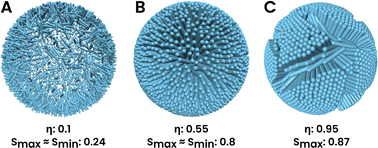Packing and emergence of the ordering of rods in a spherical monolayer†
Abstract
Spatially ordered systems confined to surfaces such as spheres exhibit interesting topological structures because of curvature induced frustration in orientational and translational order. The study of these structures is important for investigating the interplay between the geometry, topology, and elasticity, and for their potential applications in materials science, such as engineering directionally binding particles. In this work, we numerically simulate a spherical monolayer of soft repulsive spherocylinders (SRSs) and study the packing of rods and their ordering transition as a function of the packing fraction. In the model that we study, the centers of mass of the spherocylinders (situated at their geometric centers) are constrained to move on a spherical surface. The spherocylinders are free to rotate about any axis that passes through their respective centers of mass. We show that, up to moderate packing fractions, a two dimensional liquid crystalline phase is formed whose orientational ordering increases continuously with increasing density. This monolayer of orientationally ordered SRS particles at medium densities resembles a hedgehog—long axes of the SRS particles are aligned along the local normal to the sphere. At higher packing fractions, the system undergoes a transition to the solid phase, which is riddled with topological point defects (disclinations) and grain boundaries that divide the whole surface into several domains.



 Please wait while we load your content...
Please wait while we load your content...